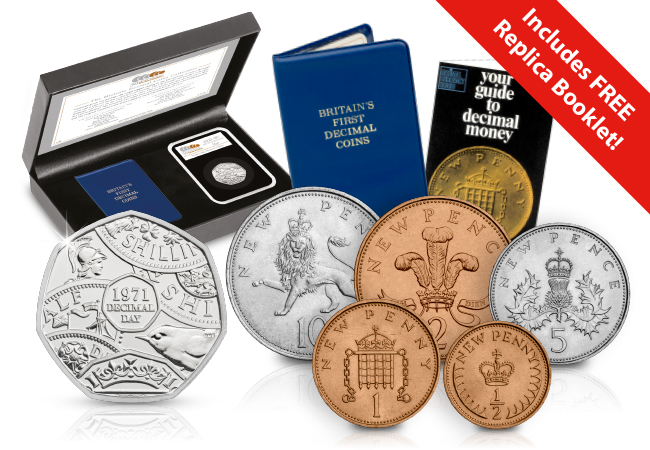Posts Tagged ‘Florin’
The reign longer than Queen Elizabeth II?
Queen Elizabeth II is Britain’s longest reigning monarch, and that means that she has adorned the obverse of our coinage since 1953 when the first coins were issued with her portrait. Her reign has seen five different portraits on our coinage and one of the biggest changes to our currency – decimalisation.
And as this month marks the 50th anniversary since the day that Britain officially went decimal, we’ve been taking a look back at British coins and how their stories have changed over time. And there’s one icon that stands out above the rest, one that has featured on coins for far longer than Queen Elizabeth II’s impressive 68 years. I am of course referring to Britannia.
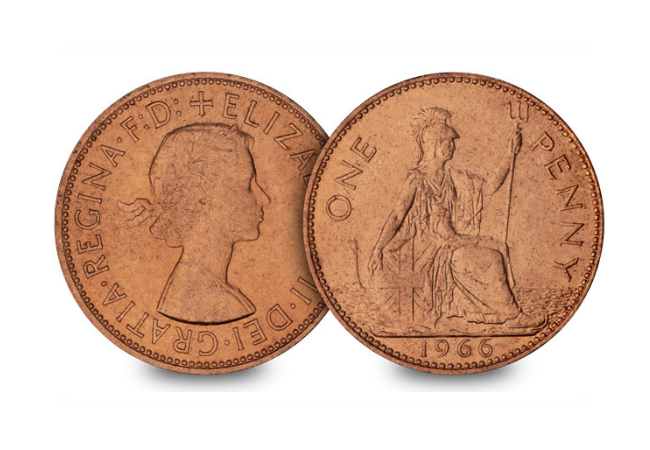
Over 2000 years old!
It’s thought that Britannia first featured on coins in Britain when the Romans arrived under Julius Caesar, but the depiction is wildly different to that which we recognize today. The coins showed a figure, neither male nor female, as a warrior with an inscription along the lines of “DE BRITANNIS”.
It wasn’t until Hadrian arrived in the second century AD that the coins started to feature a female figure with the inscription “BRITANNIA”. These Roman coins are always difficult to find, and many remain buried away even today.
A 1400 year hiatus…
This female figure disappeared from coins, and culture, for over a thousand years, not reappearing until the Tudor period. And even then it wasn’t until Charles II that she finally made her reappearance onto coinage. It’s thought that the rise of Britain as a naval power was the inspiration to include Britannia on coinage again.
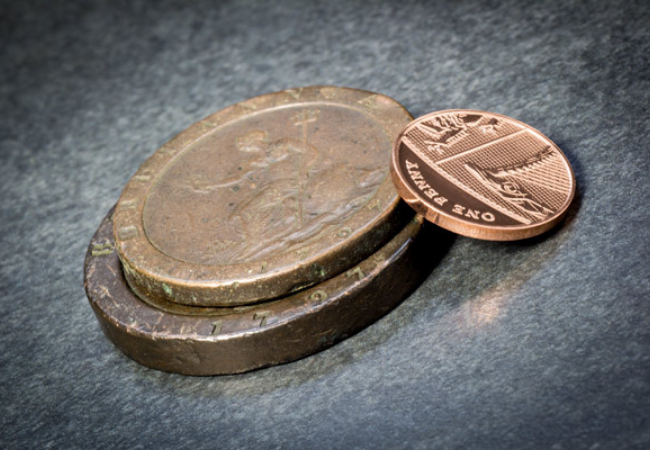
Britain’s largest penny
Under George III a one penny and two penny coin were introduced in an attempt to restore confidence in British currency. The intrinsic value of the metal plus an allowance for the cost of production was made equal to the nominal value of the coin. This made them very heavy and a lot larger than other coins in circulation – giving them the nickname ‘Cartwheels‘.
Importantly though, as Britannia had become more and more associated with the sea, these were the first coins to depict her holding a trident rather than a spear.
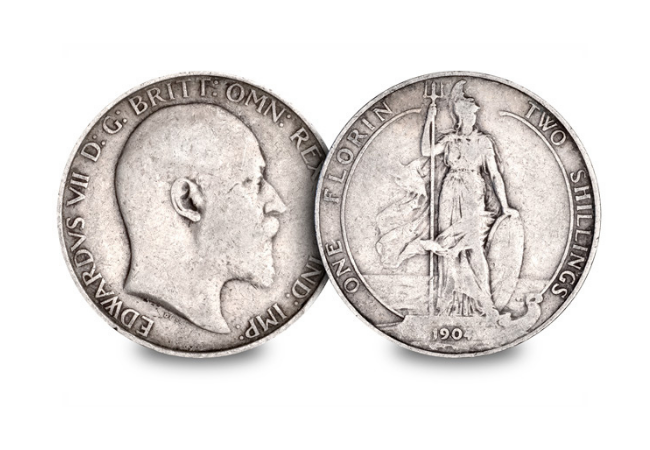
The Standing Britannia
Throughout history Britannia has been depicted on several denominations of coins, usually pennies or half pennies. Often she was shown seated with the sea in the background, and never before had she been issued on a Florin. After the long Victorian tradition of a crowned cruciform shield for the reverse, a new Britannia design was issued as King Edward VII took to the throne. A truly beautiful design, it shows Britannia with her trident, shield, and stood powerfully against the sea. Only issued during King Edward VII’s short reign, this coin has become incredibly popular for its iconic design and impressive story.
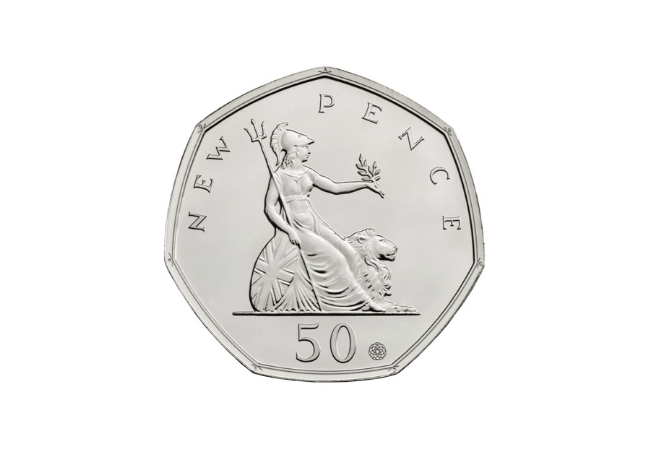
Of course the Britannia has featured and continues to feature on Britain’s coinage, with new depictions on annual releases and even special releases such as the 2019 commemorative 50p. It certainly looks like she’ll continue to have a long reign on our coinage.
If you’re interested:
Secure your very own Silver Standing Britannia Florin. At over 100 years old and with a unique design, they’re in high demand with collectors. Click here to order yours now with a deposit of JUST £13!

The Victorian attempts at decimalisation that didn’t quite go to plan…
Next month marks the 50th anniversary since the UK switched to decimal currency, leaving behind the old Pounds (£), Shillings (/-) and Pence (d) and introducing the decimalised coins we know today. You might even remember Decimal Day in 1971 yourself, using conversion charts and rhymes to learn the new currency and the excitement of seeing the new coins in your change.
In the 1820s, discussions for a new decimal currency had already begun, and in 1849 a new decimal coin was introduced in the UK. But its introduction didn’t quite go as planned and decimalisation was delayed for almost 130 years!

The Florin
The Florin first entered circulation in 1849 and had a value of 1/10th of a pound, or 24 pence (in old money). Supposedly, the name came from a similar coin issued in the Netherlands to help with decimalisation there. The Florin (or Two Shilling Coin) featured a special portrait of Queen Victoria in a medieval gothic style. It was the first time since Charles II that a monarch was depicted on a portrait wearing a crown.
Blamed for famine and sickness
The Gothic portrait was featured on the Florin when it was first introduced in 1849. Because the bust was larger than the previous Young Head portrait, the design omitted ten important letters. The words “DEI GRATIA” had been removed from the coin’s inscription. In a deeply religious society, the fact that the words meaning “by the grace of God” no longer appeared on the coin caused outrage.
Many people believed that the lack of the inscription had angered God and caused famine and sickness at the time, leading many to avoid the coin altogether.
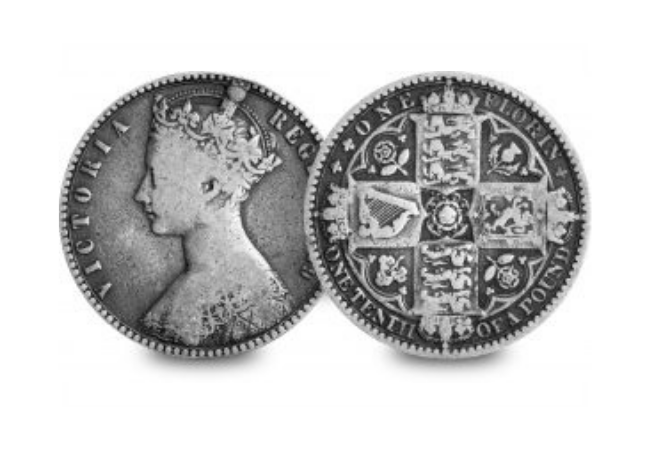
One of the shortest-lived coins in UK history
The public outrage meant that the design was altered to include a shortened version of DEI GRATIA (d.g.) by making the diameter of the coin 2mm bigger. This coin soon became the Gothic Florin and was better received by the public, but it’s safe to say that the disaster with the Godless Florin tainted the idea of decimalisation for many years. It also meant that the Godless Florin circulated for just a few years, making it one of the shortest-lived coins in our history!
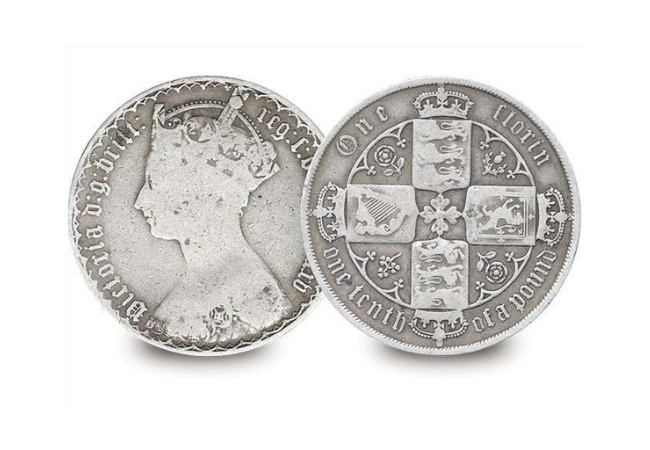
A second attempt
The Victorian’s made a second attempt at decimalisation in 1887 in the form of the Double Florin (equivalent to 1/5th of a pound, or 48 pennies), issued with a new portrait of Queen Victoria for her Jubilee. But this coin also wasn’t received well and was withdrawn from circulation completely by 1890.
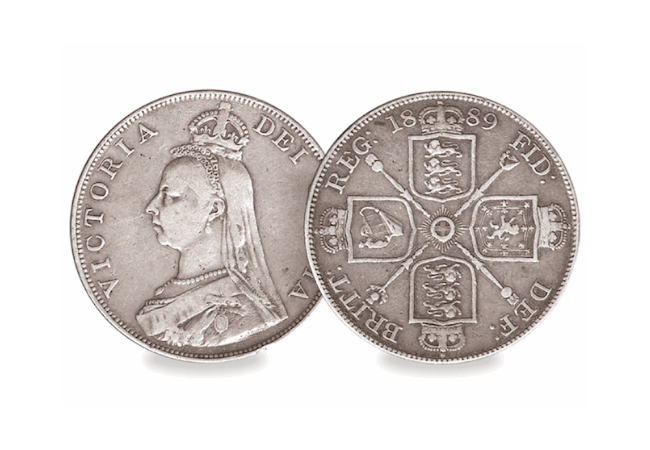
One of the features that makes the Double Florin stand out in history is that it was almost indistinguishable from the crown coin. Neither carried the denomination, and the only difference between the two (apart from the value) was that the Double Florin was 2mm smaller – not something that was easy to spot by eye. Because the two coins were so easily confused, the Double Florin became infamous for causing barmaid to lose their jobs after they short-changed pub owners!
The Victorians are famed for their innovation and sweeping changes in technology, industry, and culture. The Florin as a denomination did circulate until 1993 when it was eventually demonetised, and whilst there were countless experimentations with coinage and new denominations under Queen Victoria, it seems that the UK wasn’t quite ready for a change as big as decimalisation.
If you’re interested:
With such a fascinating story and sense of history behind it, it is no wonder that the Double Florin is such a highly-regarded British coin. Those that do remain are very difficult to track down and we have a very limited number available. And now you can spread your payment across 5 interest free instalments of JUST £19. Click here to secure yours today before they sell out!
Decimalisation: Your top five questions answered
This year marks the 50th anniversary of the Decimalisation of our currency. On 15th February 1971, known as Decimal Day (or D-Day), the country switched to the decimal currency (based on multiples of 10 and 100) that we are familiar with today. But what happened on that day, and why is it important to collectors?
Before then, Britain used a monetary system that dated thousands of years back to the Roman Empire! The problem with the old Pounds, Shillings, and Pence system (sometimes called ‘old money’) is that it was based on multiples of 12 and 240. This made it quite confusing – there were 12 pennies in a shilling and 240 pennies in a pound, and 20 shillings made a pound – certainly not easy to add up in your head!
We get a lot of questions about Decimalisation, so before we celebrate the anniversary next month, we’ve answered some of your top questions about the biggest change to UK currency ever!
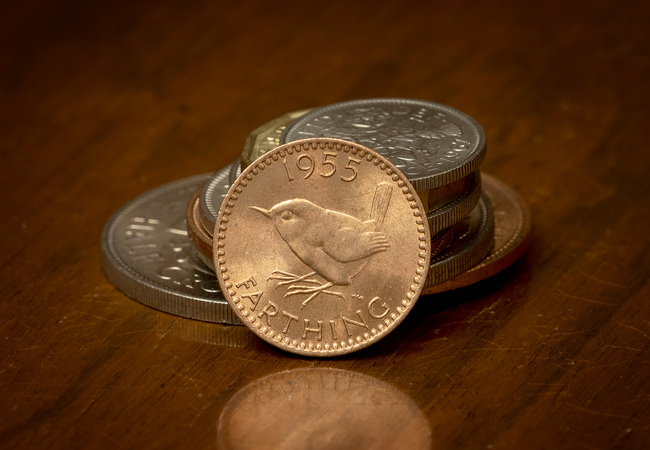
What were the coins called before Decimalisation?
The Pounds (£), Shillings (/-) and Pence (d) system included lots of coins with very different names to today’s coinage. A lot of these coins were given slang nicknames, such as ‘thrupence’ or ‘thrupny bit’ for a threepence, or a tanner for a sixpence. A Shilling was sometimes called a ‘bob’, and a ten shilling note would often be referred to as a ‘ten-bob‘ note.
| Pre-decimal Coin | Amount | Decimal Equivalent |
| Halfpenny | ½d. | 5⁄24p ≈ 0.208p |
| Penny | 1d. | 5⁄12p ≈ 0.417p |
| Threepence | 3d. | 1¼p |
| Sixpence | 6d. | 2½p |
| Shilling | 1/- | 5p |
| Florin | 2/- | 10p |
| Half Crown | 2/6 | 12½p |
| Crown | 5/- | 25p |
Who was the first country to go decimal?
Did you know the UK wasn’t the first country to go decimal? In fact, as early as 1704 Russia introduced the Ruble which was equal to 100 Kopecks, making it the first country to have a decimal coin. It was followed by France which introduced the Franc in 1795. Although the UK was one of the last to turn decimal, discussions first started in Britain as early as the 1820s, but the idea didn’t take off well with the public so it wasn’t until 150 years later that it actually happened.
When were the first decimal coins issued?
The first new decimal coins were actually issued before decimal day in 1971 – three years earlier in fact! In 1968 the plans for decimalisation were set in motion. To try and help the public acclimatise to the new decimal coins, the 5p and 10p, were issued, followed by the 50p a year later in 1969. This meant that the coins circulated alongside their pre-decimal siblings (Shilling, Florin, and 10 bob note) and were used interchangeably. By 1971 when the pre-decimal coinage ceased to be legal tender, only 3 new coins would be introduced (Half pence, one pence, two pence), making the jump to decimal currency a little easier for the public.
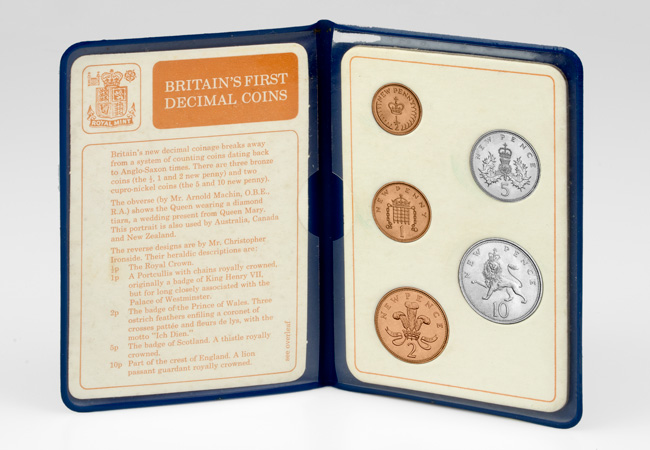
Why did the banks close for four whole days?
In 1971, very few banks used digital systems so on 10th February the banks closed for four days until Decimal Day. This allowed all outstanding cheques to be cleared in old money and all customers accounts to be converted into decimal coinage – and because most banks weren’t computerised, this had to be done manually! February was actually chosen as it was the quietest time of year for banks, shops, and public transport. It’s hard to imagine the banks closing for four days in a row now!
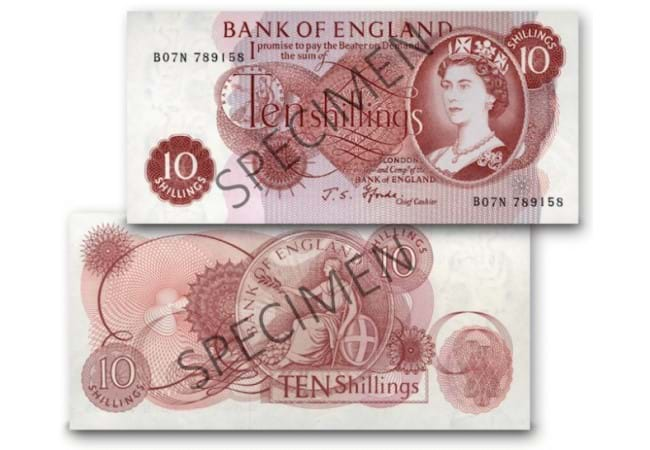
How did people compare between the two currencies?
Many people worried about shopkeepers inflating the prices of products during the changeover, but with a public information campaign that ran for almost 2 years prior, many people already had some idea of the conversions. And to help, currency convertors were made available to people, and shops displayed the prices in both currencies before and after Decimal Day. People could also continue to pay in old money, but they would receive their change in new money.
It took some time, but soon the decimal currency became familiar to everyone and continues to be the biggest change to UK coinage in thousands of years. In the lead up to the 50th anniversary, we’ll be issuing a series of blogs telling you all you need to know about this iconic moment in numismatic history, so make sure to stay tuned!
If you’re interested:
You can commemorate the 50th anniversary of Decimalisation now with the Historic Decimal Coins Collection! Including an ORIGINAL Decimal Coin Wallet, BRAND NEW BU 50p, and a FREE replica booklet. Click here to secure your Historic Decimal Coins Collection for JUST £29.99!


